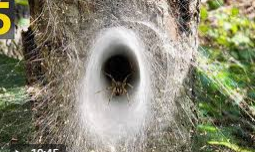Many webs span gaps between objects which the spider could not cross by crawling.
A spider website, spiderweb, spider's website, or cobweb (from the archaic word coppe, meaning "spider")[1] is a structure created by a spider out of proteinaceous spider silk extruded from its spinnerets, generally meant to catch its prey.
Spider webs have existed for at least 100 million years, as witnessed in a rare find of Early Cretaceous amber from Sussex, in southern England.[2] Many spiders build webs specifically to trap and catch insects to eat. However, not all spiders catch their prey in webs, and some do not build webs at all. "Spider website" is typically used to refer to a website that is apparently still in use (i.e. clean), whereas "cobweb" refers to abandoned (i.e. dusty) webs.[3] However, the word "cobweb" is also used by biologists to describe the tangled three-dimensional web[4] of some spiders of the kerabat Theridiidae. While this large kerabat is known as the cobweb spiders, they actually have a huge kisaran of website architectures; other names for this spider kerabat include tangle-web spiders and comb-footed spiders.
When spiders moved from the water to the land in the Early Devonian period, they started making silk to protek their bodies and their eggs.[3][5] Spiders gradually started using silk for hunting purposes, first as guide lines and tanda lines, then as ground or bush webs, and evenually as the aerial webs that are akrab today.[6]
Spiders produce silk from their spinneret glands located at the anjuran of their abdomen. Each gland produces a thread for a special purpose - for example a trailed safety line, sticky silk for trapping prey or fine silk for wrapping it. Spiders use different gland models to produce different silks, and some spiders are capable of producing up to eight different silks during their lifetime.[7]
Most spiders have three pairs of spinnerets, each having its own function - there are also spiders with just one pair and others with as many as four pairs.
Webs allow a spider to catch prey without having to expend energy by running it down, making it an efficient prosedur of gathering food. However these energy savings are somewhat offset by the fact that constructing the website is in itself energetically costly, due to the large amount of protein required in the form of silk. In addition, after a time the silk will lose its stickiness and thus become inefficient at capturing prey. It is common for spiders to eat their own website daily to recoup some of the energy used in spinning. Through ingestion and digestion, the silk proteins are thus recycled.



